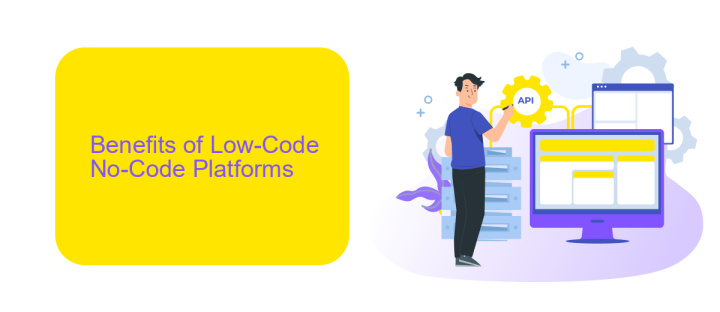Low-Code No-Code Platform Companies
In today's rapidly evolving technological landscape, Low-Code and No-Code platforms are revolutionizing the way businesses develop software. These innovative solutions empower users with little to no programming experience to create robust applications quickly and efficiently. By democratizing software development, Low-Code and No-Code platforms are driving digital transformation, accelerating time-to-market, and reducing costs for companies of all sizes.
Introduction and Definition
Low-Code No-Code platforms are revolutionizing the way businesses develop applications by minimizing the need for extensive coding knowledge. These platforms enable users to create, modify, and deploy applications with minimal hand-coding, making software development accessible to a broader audience. They empower non-technical users, such as business analysts and project managers, to participate in the development process, thus accelerating innovation and reducing development costs.
- Low-Code Platforms: These require some level of coding but significantly reduce the amount of hand-coding needed.
- No-Code Platforms: These allow users to create applications without any coding knowledge, utilizing visual interfaces and pre-built modules.
One of the key advantages of these platforms is their ability to integrate with various services and tools effortlessly. For instance, ApiX-Drive offers seamless integration capabilities, allowing users to connect different applications and automate workflows without writing a single line of code. This enhances productivity and ensures that businesses can adapt quickly to changing market demands.
Benefits of Low-Code No-Code Platforms

Low-code and no-code platforms offer significant benefits, particularly in accelerating the development process. These platforms enable users with minimal technical skills to create applications through intuitive visual interfaces and pre-built templates. This democratizes software development, allowing business users to quickly prototype and iterate without the need for extensive coding knowledge. The result is faster time-to-market and reduced development costs, which can be a game-changer for businesses looking to stay competitive.
Another key advantage is the ease of integration with existing systems and services. Platforms like ApiX-Drive facilitate seamless integration, enabling users to connect various applications and automate workflows effortlessly. This enhances operational efficiency and ensures that data flows smoothly between different systems, reducing manual effort and the risk of errors. In essence, low-code and no-code platforms empower organizations to innovate rapidly while maintaining flexibility and control over their digital ecosystems.
Challenges and Limitations of Low-Code No-Code Platforms

While Low-Code No-Code (LCNC) platforms offer many benefits, they also come with several challenges and limitations. These platforms can sometimes fall short in addressing complex business requirements and may not provide the same level of customization as traditional coding.
- Scalability Issues: LCNC platforms may struggle to handle large-scale applications, limiting their use for enterprise-level projects.
- Integration Limitations: Integrating with other systems can be challenging. While services like ApiX-Drive can help automate and streamline integrations, they may not cover all scenarios.
- Security Concerns: These platforms may not offer the same level of security measures as custom-coded solutions, making them vulnerable to security breaches.
- Vendor Lock-In: Relying heavily on one LCNC platform can result in vendor lock-in, making it difficult to switch providers or migrate to other systems.
- Limited Customization: LCNC platforms often provide limited customization options, which can be a significant drawback for projects requiring specific features or functionalities.
Despite these challenges, LCNC platforms continue to evolve, offering increasingly robust solutions. However, businesses should carefully assess their specific needs and consider these limitations before fully committing to a LCNC approach.
Market Overview and Key Players

The Low-Code No-Code (LCNC) platform market has experienced rapid growth, driven by the increasing demand for quicker application development and the democratization of software creation. These platforms empower users with minimal coding skills to build and deploy applications efficiently, reducing reliance on professional developers.
Several key players dominate the LCNC platform market, each offering unique features and capabilities that cater to diverse business needs. These companies are at the forefront of innovation, enabling organizations to accelerate digital transformation and improve operational efficiency.
- Microsoft Power Apps
- OutSystems
- Mendix
- Appian
- ApiX-Drive
ApiX-Drive stands out for its robust integration capabilities, allowing businesses to seamlessly connect various apps and services without extensive coding. This not only simplifies workflows but also enhances productivity by automating data transfers and processes. The LCNC platform market is poised for continued growth as more companies recognize the value of these tools in driving innovation and agility.
Future Trends and Outlook
As we look towards the future of Low-Code No-Code platforms, several trends are set to shape the industry. One of the most significant trends is the increasing adoption of artificial intelligence and machine learning within these platforms. By integrating AI capabilities, these platforms can offer more advanced automation and predictive analytics, making it easier for businesses to create intelligent applications with minimal coding. Additionally, the rise of citizen developers—non-technical users who can develop applications—will continue to drive the demand for more intuitive and user-friendly interfaces.
Another key trend is the growing importance of seamless integrations with other software and services. Platforms like ApiX-Drive are becoming essential as they enable businesses to easily connect various applications and automate workflows without extensive coding knowledge. This focus on integrations will allow Low-Code No-Code platforms to offer more comprehensive solutions, catering to the diverse needs of businesses. As these platforms evolve, we can expect to see even more robust features and capabilities, solidifying their role as indispensable tools in the modern business landscape.
FAQ
What is a Low-Code/No-Code platform?
Who can benefit from using Low-Code/No-Code platforms?
Are Low-Code/No-Code platforms secure?
Can Low-Code/No-Code platforms integrate with other tools and services?
What types of applications can be built using Low-Code/No-Code platforms?
Apix-Drive is a universal tool that will quickly streamline any workflow, freeing you from routine and possible financial losses. Try ApiX-Drive in action and see how useful it is for you personally. In the meantime, when you are setting up connections between systems, think about where you are investing your free time, because now you will have much more of it.

